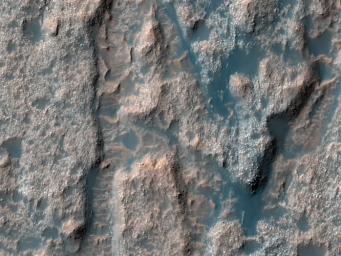Deposits on the Floor of Palos Crater
Caption:
This image shows a portion of the floor in Palos Crater on equatorial Mars.
The floor appears bumpy with high-standing layered knobs. Most of the terrain on the floor is weathering into meter-size (yard-size) polygonal blocks. The circular structures in the image, many of which are filled with darker wind-blown material, are eroded impact craters.
Palos Crater is breached in the south by the 180-kilometer-long (112-mile-long) Tinto Vallis. Water transported along Tinto Vallis could have could have collected into Palos Crater to form a lake that later drained to the north. Sediments carried by Tinto Vallis would have also been deposited within Palos Crater, so the layered unit we see along the floor today could represent these fluvial sediments.
This image covers a swath of ground about 1 kilometer (about two-thirds of a mile) wide. It is a portion of HiRISE observation ESP_016943_1775, which is centered at 2.67 degrees south latitude, 111.13 degrees east longitude. The season on Mars is southern-hemisphere autumn. Other image products from this observation are available at
http://hirise.lpl.arizona.edu/ESP_016943_1775
.
Background Info:
The High Resolution Imaging Science Experiment (HiRISE) camera on NASA's Mars Reconnaissance Orbiter recorded this image on March 8, 2010. The target for this HiRISE observation was a suggestion submitted through the camera team's HiWish public-suggestion program. For more information about how to submit target suggestions, see
http://uahirise.org/hiwish/
.
Color images from HiRISE combine information from detectors with three different color filters: red, infrared, and blue-green. Thus they include information from part of the spectrum human eyes cannot see and are not true color as the eye would see. The resulting false color helps to show differences among surface materials.
The University of Arizona, Tucson, operates the HiRISE camera, which was built by Ball Aerospace & Technologies Corp., Boulder, Colo. NASA's Jet Propulsion Laboratory, a division of the California Institute of Technology, Pasadena, manages the Mars Reconnaissance Orbiter for the NASA Science Mission Directorate, Washington. Lockheed Martin Space Systems, Denver, built the spacecraft.
Cataloging Keywords:
| Name |
Value |
Additional Values |
| Target |
Mars |
|
| System |
|
|
| Target Type |
Planet |
|
| Mission |
Mars Reconnaissance Orbiter (MRO) |
|
| Instrument Host |
Mars Reconnaissance Orbiter |
|
| Host Type |
Orbiter |
|
| Instrument |
High Resolution Imaging Science Experiment (HiRISE) |
|
| Detector |
|
|
| Extra Keywords |
Color, Crater, Impact, Infrared, Water |
| Acquisition Date |
|
| Release Date |
2010-03-31 |
| Date in Caption |
|
|
| Image Credit |
NASA/JPL-Caltech/University of Arizona |
| Source |
photojournal.jpl.nasa.gov/catalog/PIA12994 |
| Identifier |
PIA12994 |

 Planetary Data System
Planetary Data System
